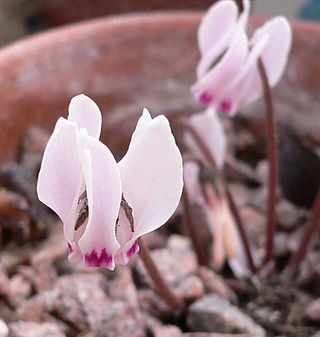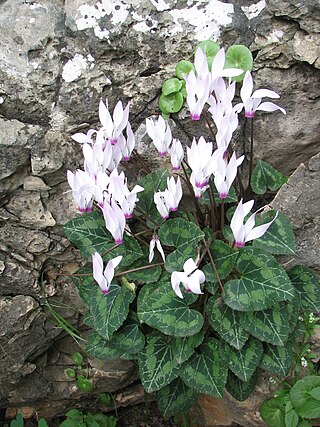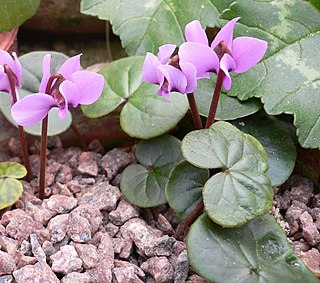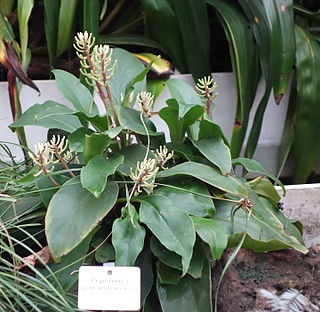
Cyclamen is a genus of 23 species of perennial flowering plants in the family Primulaceae. In English, it is known by the common names sowbread or swinebread. Cyclamen species are native to Europe and the Mediterranean Basin east to the Caucasus and Iran, with one species in Somalia. They grow from tubers and are valued for their flowers with upswept petals and variably patterned leaves.
A storage organ is a part of a plant specifically modified for storage of energy (generally in the form of carbohydrates) or water. Storage organs often grow underground, where they are better protected from attack by herbivores. Plants that have an underground storage organ are called geophytes in the Raunkiær plant life-form classification system. Storage organs often, but not always, act as perennating organs which enable plants to survive adverse conditions.

Piper aduncum, the spiked pepper, matico, hierba del soldado, achotlín, cordoncillo, higuillo or higuillo de hoja menuda, is a flowering plant in the family Piperaceae. Like many species in the family, the matico tree has a peppery odor. It grows wild on the coasts and in the forests of Central and South America and in the Interandean Valleys, up to 3,000 m (9,800 ft) above sea level.
Ramularia menthicola is a species of fungus in the family Mycosphaerellaceae. It is a plant pathogen that infects mint. It was formally described as a new species by the Italian mycologist Pier Andrea Saccardo in 1886. In his 1998 monograph on phytopathogenic Hyphomycetes, Uwe Braun suggests that Ramularia menthae should be considered a synonym to Ramularia lamii, but the name remains in use in the scientific literature, and is accepted as a valid species by Index Fungorum.

Mycosphaerella is a genus of ascomycota. With more than 10,000 species, it is the largest genus of plant pathogen fungi.

Cyclamen cyprium is a perennial growing from a tuber, native to woodland at 300–1,200 m (980–3,940 ft) elevation in the mountains of Cyprus. It is the national flower. Cyclamen persicum and Cyclamen graecum are also found on Cyprus, but are not endemic.

Ramularia is a genus of ascomycete fungi. Its species, which are anamorphs of the genus Mycosphaerella, are plant pathogens. Economically important host species include Narcissus, sugar beet, and barley.

Cyclamen hederifolium, the ivy-leaved cyclamen or sowbread, is a species of flowering plant in the family Primulaceae. This widespread cyclamen species is widely cultivated and among the most hardy and vigorous in oceanic climates. It is native to woodland, shrubland, and rocky areas in the Mediterranean region from southern France to western Turkey and on Mediterranean islands, and naturalized farther north in Europe and in the Pacific Northwest.

Cyclamen purpurascens, the purple cyclamen, is a species of flowering plant in the genus Cyclamen of the family Primulaceae, native to central Europe, northern Italy, and former Yugoslavia. It is an evergreen tuberous perennial with (usually) variegated leaves, and deep pink flowers in summer.

Cyclamen coum, the eastern sowbread, is a species of flowering plant in the family Primulaceae. It is a tuberous herbaceous perennial, growing to 5–8 cm (2–3 in), with rounded heart-shaped leaves and pink shell-shaped flowers with darker coloration at the base. It is valued in horticulture as groundcover, and for the flowers which bloom in winter and early spring.

Cyclamen persicum, the Persian cyclamen, is a species of flowering herbaceous perennial plant growing from a tuber, native to rocky hillsides, shrubland, and woodland up to 1,200 m (3,900 ft) above sea level, from south-central Turkey to Lebanon-Syria and the Palestine region. It also grows in Algeria and Tunisia and on the Greek islands of Rhodes, Karpathos, and Crete, where it may have been introduced by monks. Cultivars of this species are the commonly seen florist's cyclamen.

Cyclamen parviflorum, the small-flowered cyclamen is a flowering perennial plant growing from a tuber, native to high elevations in the Pontic Mountains of northern Turkey. It is the smallest cyclamen species and the only one native to alpine tundra.

Cyclamen alpinum is a perennial plant growing from a tuber, native to an area of southwestern Turkey, northwest of Antalya. It is isolated from other species of the Cyclamen coum group.

Cyclamen repandum, the spring sowbread, is a species of flowering plant in the family Primulaceae, native to southern Europe and some Mediterranean islands. It is the most widespread of a group of cyclamens with wide, heart-shaped leaves, often coarsely toothed or lobed, and late spring-blooming flowers with long, slender petals.

Cyclamen africanum is a species of flowering plant in the family Primulaceae. It is referred to by the common name African cyclamen and is a perennial growing from a tuber, native to northern Algeria, Morocco and Tunisia. It is similar to Cyclamen hederifolium, but not frost-hardy.
Martrel Reeves, better known by his stage name Fat Trel, is an American rapper. He is currently signed to MGE The Label with distribution of Asylum Records. He was previously signed to Rick Ross's label Maybach Music Group and Atlantic Records. And was also signed to DTLA Records with the distribution with Beryl Media. From 2009 to 2016, Reeves released solo mixtapes every year.

Cercosporella is a fungus genus in the family Mycosphaerellaceae.

Peperomia pernambucensis is a species of plant in the genus Peperomia in the family Piperaceae. Its native range is in Central and South America from Nicaragua to Bolivia.

Ramularia ulmariae is a fungal species described by Cooke in 1876. Ramularia ulmariae belongs to the genus Ramularia and the family Mycosphaerellaceae. No subspecies are listed in the Catalog of Life.















